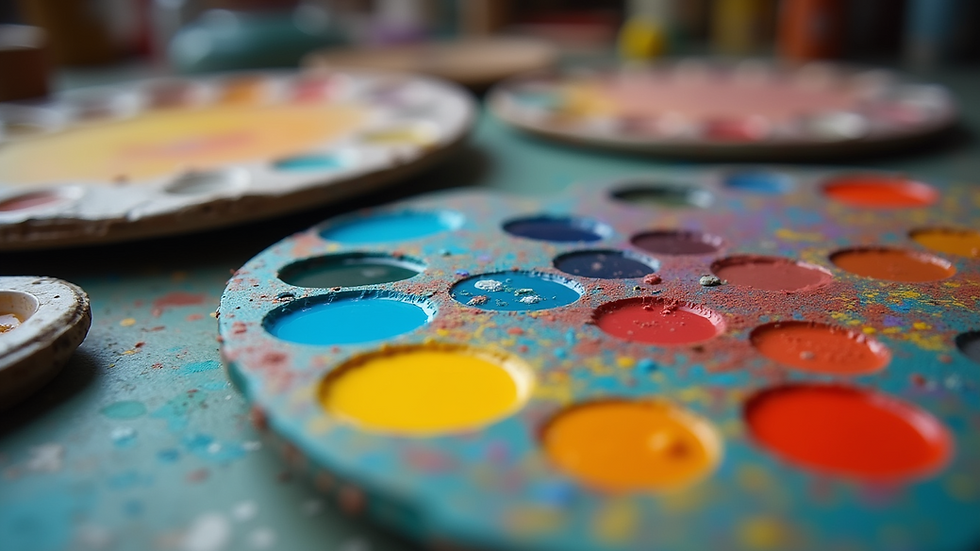Discover the Therapeutic Benefits of Painting for Mindfulness and Stress Relief
- Joseph Papini

- Sep 6, 2025
- 3 min read
Painting is more than a fun hobby; it is a powerful tool for improving mental health. Many people discover that spending time painting can calm the mind and promote mindfulness, similar to how meditation works. This blog post unpacks the therapeutic effects of painting, how it encourages relaxation, and the various ways it can enhance mental well-being.
The Connection Between Art and Mental Health
Art is a powerful way to express emotions, yet its mental health benefits are often underappreciated. Engaging in creative activities like painting helps individuals process feelings, lower stress levels, and enhance mental health overall. For example, studies show that art therapy can reduce symptoms of anxiety in nearly 75% of participants. Painting allows for self-expression, providing a safe space to explore complex emotions that might be hard to put into words.
When people immerse themselves in painting, they often find a state of flow. This means they become so engaged in the creative process that worries fade away. During this state of focus, many experienced a 30% reduction in anxiety according to research from the American Art Therapy Association.

The Meditative Qualities of Painting
Much like meditation, painting encourages focusing on the present moment. The simple, repetitive actions of brush strokes and color blending create a rhythm that calms the mind. This process can help release pent-up stress and emotions, making it an effective tool for relaxation.
Many individuals report feeling mentally clearer after painting. This clarity can assist problem-solving and decision-making, as distractions fade away. For instance, a survey revealed that 67% of people dealing with depression noticed improvements in their mood after regularly engaging in painting activities.
Enhancing Creativity and Self-Expression
Beyond relaxation, painting serves as a unique form of self-expression, allowing individuals to convey feelings and experiences visually. This can be incredibly important for those who find verbal expression challenging. For example, a young adult might paint a stormy ocean to represent their feelings of confusion and fear, helping others understand their emotional state without the need for words.
The creative process in painting also boosts self-esteem and problem-solving skills. Completing a piece of artwork brings a real sense of achievement. For instance, when community programs encourage painting for mental health, 80% of participants reported feeling more confident in their abilities after just a few sessions.

The Role of Color in Emotional Well-Being
Colors in painting can greatly affect emotions. Various colors evoke different feelings. For example, warm colors like red and orange can energize and excite, while cool colors like blue and green can create feelings of calm and peace.
Artists typically select colors based on how they feel or the emotion they wish to express. This thoughtful use of color can enhance the painting's therapeutic effects, allowing individuals to dig deeper into their emotions. By exploring different color palettes, artists might reveal insights about their feelings that they were previously unaware of.
Creating a Relaxing Painting Environment
To truly benefit from painting, it is vital to create the right atmosphere. A peaceful and inviting space can significantly enhance the experience, making relaxation more achievable. Here are some suggestions for setting up your ideal painting area:
Choose a Quiet Space: Look for a spot free from distractions. This helps maintain focus on your art and makes it easier to enter a meditative state.
Gather Your Supplies: Organize all your painting materials and keep them within reach. This way, you can dive straight into the creative process without interruption.
Incorporate Natural Elements: Surround yourself with plants or enjoy natural light. Nature has a calming effect that enriches your painting experience.
Play Soft Music: Gentle background music can help create a relaxing vibe while you paint.

Embracing the Artistic Journey
The therapeutic benefits of painting are varied and profound. By taking part in this creative practice, individuals can find calm, enhance emotional well-being, and cultivate mindfulness. Whether you are a seasoned artist or just getting started, painting can be a valuable tool for stress relief and self-expression.
As you explore the art of painting, remember to enjoy the process rather than solely focusing on the end result. Allow yourself to be present in each moment and let the colors and brush strokes guide you toward a more peaceful state of mind. The journey of creativity can lead to rich insights and a deeper understanding of oneself, making painting a truly rewarding and therapeutic experience.



Comments